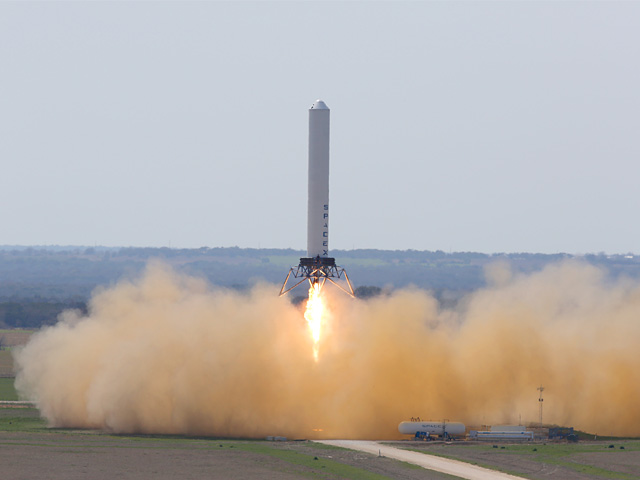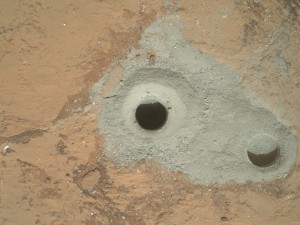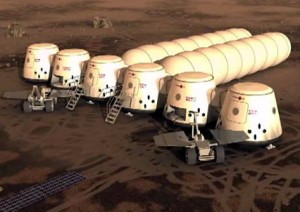It’s the Ides of March and unless you are unaware of the auspiciousness of this Caesarian date, it is also the day for me to post weekly headlines that I want to share with you, my readers. This week I have picked a few stories about developments in and from space:
- Curiosity Gives Us a Better Picture of the Martian Past;
- SpaceX Latest Hopping Rocket Feat;
- Russia and Europe to Explore Mars Together;
- Mars One Contracts Company to Design Space Survival Systems;
- Have Ancient Fossils Been Found in Meteor Fragments?
Drilling into Martian Rocks Gives Us a Picture of the Planet’s Past
At some point in Martian history conditions there were benign and wet enough to support life. That is the conclusion of scientists reviewing data from the analysis of the powder Curiosity sampled after drilling into sedimentary rock near what was once an ancient river bed in Gale Crater. The Sample Analysis at Mars (SAM) and Chemistry and Mineralogy (CheMin) instruments identified sulfur, nitrogen, hydrogen, oxygen, phosphorus and carbon, all key ingredients for life, in the drilled sample. The drilled rock is mudstone, a clay like mineral. The water conditions in which this rock sample formed were such that if we were on Mars at that time we could have dipped a cup into the stream and drunk from it. Curiosity will continue to examine samples to confirm these results but John Grotzinger, the Mars Science Laboratory project scientist at Caltech stated, “We have characterized a very ancient, but strangely new ‘gray Mars’ where conditions once were favorable for life.”
SpaceX Continues its Quest to Create a “Buck Rogers” Reusable Rocket
Last week SpaceX conducted its latest Vertical Takeoff Vertical Landing (VTVL) experiment in McGregor, Texas, using a modified Falcon-9 rocket with only a single Merlin engine. Normally the Falcon has nine engines but this one, aptly named Grasshopper, has a modified undercarriage and one engine. It has undergone several tests in the past few months that demonstrate controlled vertical takeoffs and landings. The first flew 2.5 meters (8.2 feet) and landed. The second 5.4 meters (17.7 feet). The third flew 40 meters (131 feet). And this latest, the fourth, ascended to 80 meters (approximately 260 feet), hovered for 34 seconds and then descended to land dead on target on the launch pad. What SpaceX hopes to achieve is totally reusable rockets that can boost capsules into orbit and then return and land, driving down the cost of getting to and from low-Earth orbit. The same technology is planned for the SpaceX Dragon capsule so that on returning from space it too will be able to land just like those old Buck Rogers rockets.
Europe and Russia to Collaborate on Exploring Mars
NASA pulled out of two planned Martian missions involving the European Space Agency (ESA) this week citing funding cuts. Hard on the heels of that announcement came a new initiative involving collaboration between Roscosmos and ESA with Mars the target. The missions are planned for 2016 and 2018 and the latter will include an ESA built rover. The Russians will provide the launch and descent vehicles. The first mission includes a Trace Gas Orbiter and a lander, called the EDM, which will be placed on the planet’s surface. The second will also include an orbiter and deliver the ExoMars rover to the surface. ExoMars’ scientific payload includes a drill capable of reaching to depths of 2 meters (over 6 feet) to search for evidence of Martian life. Roscosmos and ESA have also started planning for a sample-return mission to bring Martian soil samples back to Earth for analysis.
Mars One Contracts Paragon to Develop Life Support Systems for Martian Colonies
Paragon, a company headquartered in Tucson, Arizona, builds life support and environmental controls systems for use in hazardous environments. It has been contracted to work with NASA on Orion, the Multi-Purpose Crew Vehicle for Deep Space missions, as well as work on a next generation of spacesuits. Mars One, if you are not familiar with it announced in 2012 its ambitious plan to place a human settlement on Mars by 2023. One of the key hurdles to overcome is the development of closed loop environmental control and life support systems for the spaceship that will take the first pioneers to the planet, the habitats that will be used upon arrival, and for spacesuits to allow the Martian colonists to work and explore outside. Paragon’s role will be to identify suppliers, and architect solutions that will provide a self-sustaining environment.
December Sri Lankan Meteorite Contains Evidence of Panspermia
Last December a meteor lit up the skies over Sri Lanka. Fragments scattered over the countryside and locals gathered them and sent them to the Sri Lankan Medical Research Institute in Colombo, Sri Lanka’s capital. From there the fragments, dubbed the Polonnaruwa meteorite, were sent to astrobiologists at Cardiff University in the United Kingdom. Testing has yielded some extraordinary findings. There appears to be evidence of fossilized biology in the rocky fragments. One contained an abundance of organic compounds suggesting that the meteorite was derived from a comet. Imaging of fragments yielded “thick-walled, carbon rich” microfossils about 100 micrometers across. These microfossils resemble extinct marine algae. One image displayed “well-preserved flagella” about 2 micrometers in diameter and 100 micrometers in length (see image below). The microfossils were found deeply embedded in the meteor fragments surrounded by a carbonaceous layer that resembled burned asphalt. This isolation of the fossil remains convinced the Cardiff University team to make the following statement. “This [finding] provides clear and convincing evidence that these obviously ancient remains of extinct marine algae found embedded in the Polonnaruwa meteorite are indigenous to the stones and not the result of post-arrival microbial contaminants.” This meteorite may be terrestrial in origin, ejected from Earth by a previous impact billions of years ago, and only now has come back home. Or it is evidence of the ideas first brought forth by Fred Hoyle and Chandra Wickramasinghe more than a half-century ago when they proposed that life on Earth first came from space. They called this panspermia.
A Postscript
Let me know what you think of taking a themed approach like this to weekly headlines where I look at one specific field. Or do you like the multi-discipline approach I usually provide? Either way it is great to have you as readers and I welcome your questions and comments.
– Len Rosen













